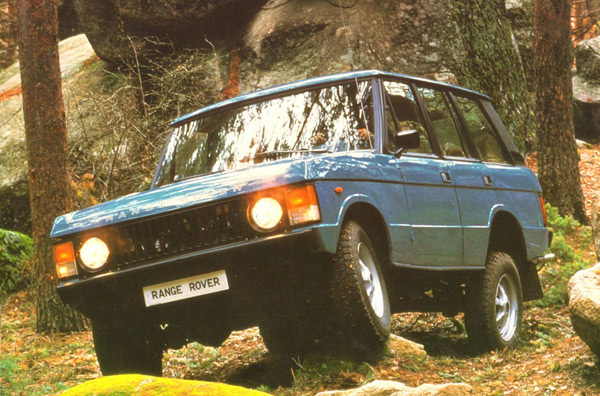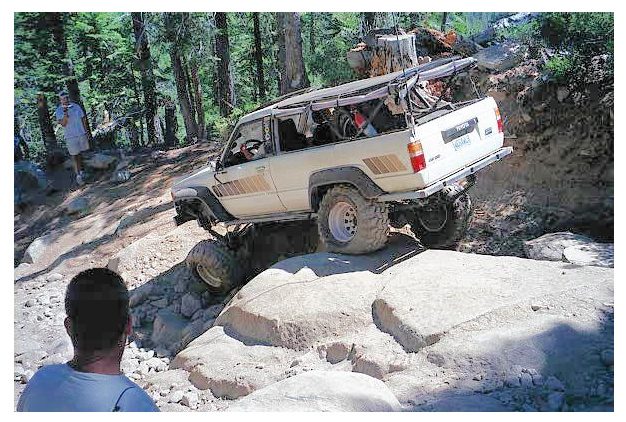
In the 70's and 80's, off-road vehicle like the Jeep and Toyota trucks had stiff suspension and rode rough. The American truck purposely made the suspension stiff so it would feel "tough". In 1987, Range Rover was introduced in the US. It was marketed as a luxury vehicle. Charles Hughes, president of Range Rover North America expected the vehicle to be bought be someone with an income excess of $100k. Back then, that was quite a bit of change considering if an entry level engineering position paid $25k, that was a lot of money. (That amount tempted me to get into engineering)
The unique thing about the Range Rover was its soft suspension that gave a lot of articulation. Is famous for the "magic carpet" ride. In the early 90's, Four Wheeler magazine introduced a articulation measure called the RTI, or ramp travel index. From late 90's to early 2000, RTI was all the rage in off-roading. It was a dimensionless number that is proportional to height of one wheel on a 20 deg ramp divided by wheelbase. People talked about what their truck RTI number was. In the early 2000, when serious rock crawling started, RTI number dropped out of favor. Articulation was a given by then. Specialized trail machine could almost twist the axel 90 degree to each other. These machines tackled terrain that was unheard of before. In the 80's serious off-roading was considered a steep hill. In the 90's the Rubicon trail was the ultimate off-roading trail. Starting 2000, people started going over boulders as tall as the truck itself. Breakage of parts became more important then. More important was how much torque the steering axel can take on the axel test machine.
For reference, a Jeep Wrangler YJ had RTI of 357. 96 Jeep Grand Cherokee was 422. But a 92 first generation Range Rover, had a RTI of 670. The typical truck suspension in the 80s had a stiffness of about 300 lb/in while the Range Rover was twice as soft at about 150 lb/in. The Range Rover was considered the best off-roader in the world due to its marketing of itself as the vehicle of choice for the rich, and the royalties. As a result, the rest of the bourgeois class decided they want to modify their trucks to have just as much articulation as the Range Rover. Nobody ever talked about imitating the Range Rover, but it was implied that they want their truck to be comprable to the Rover's off-road ability. There was articulation envy going on in that period of time during the 90's.

Various web sites and forum describe various reasons for articulation. It is generally accepted that articulation made for a more capable off-roading rig.
The most obvious reason for articulation is if the truck have an open differential.With stiff suspension, one wheel will be off the ground, and all traction would be lost. This has always accepted as the original reason for articulation.
Roger Brown described in his 4crawler web site the advantage of articulation even though his rig have locking differential on both axel. Dropping into the Big Sluice at the Rubicon trail, it gives the vehicle more stability.

When one wheel drops off a ledge, with a stiff suspension, the car will stay level until the balance point is reached, then the car will tip over and seasaw one corner into the drop off. That would not be a problem for traction, but since a truck has momentum, when the one wheel hit the bottom of the drop off, the truck will continue to roll and possible flip over. However, the theory is that when the front axel is allowed to drop down into the ledge, then the shock absorber can slow the seasaw action of the car going into the drop off.
On the flip side of the coin, with soft suspension, the truck will tend to lean more in an off camber situation, and could possibly reach a tipping that way also. With a stiff suspension, if you have to go over a steep ledge, one way to do it is to slowly find the balance point, and creep forward to slowly tip the truck over to slow the momentum down. With skillful driving, you could come out ahead in this situation with a stiff suspension.
Here is the final reason why articulation makes for a better off-road vehicle. Articulation allows weight of the vehicle to distrubute evenly on all tires. You might ask why that is important if there is already a locker on both axel and a locker in the center differential. Is the same reason tanks use treads. Treads on a tank spread the weight of the vehicle over a large area so a heavy tank can float on top of sand and mud for better traction.
In the same way, when weight is evenly distributed over all 4 tires, the car can better float over the sand and mud for better traction. Since the weight of the truck is fixed, the optimal situation is to spread it over the maximum area possible. That would be all 4 tires. Now, if you lower the pressure on each tire, then each tire would have a bigger contact area to further spread the weight for traction. With a stiff suspension, if the truck is going over uneven terrain, one tire would get more weight than the opposite side. The result is that even if you lower the tire pressure, with added weight, the tire will sink into the terrain more since it has more weight on it. Once a tire starts to sink, it has to fight harder to climb up the terrain in order to have forward traction. However, with a soft suspension, even in uneven terrain, none of the tires would sink into the terrain for best traction.
What about rock crawling. In rock crawling the surface is already hard, and tires don't sink into the rocks. Classical physics say that the more weight you put on a tire, the more traction. However, in the real world, there is deminishing returns. You do not necessary get more traction if you put more weight on a tire. It is still best to have articulation to spread the weight so that each tire has to work less.
There may be an exception to the articulation rule. In some rock crawling situation, it may be advantageous to use forward momentum to ram into a rock. A stiff suspension would exert more force on a tire for momentary higher traction. That would be a very specialized manuver that is not applicable to general off-roading.
Therefore the final conclusion is articulation give you better traction even with a locked differential because it spreads the weight of the truck over all 4 tires.